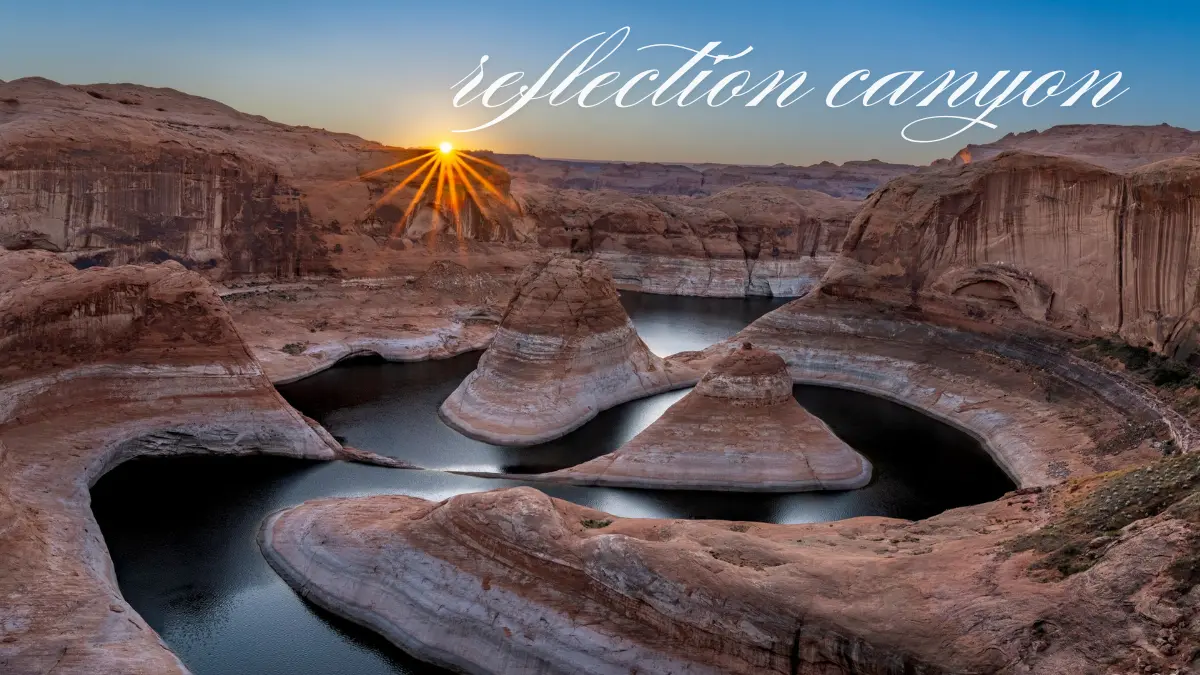Nestled deep within the rugged and remote terrain of southern Utah, Reflection Canyon is a spectacular natural wonder that continues to captivate the hearts of adventurers and photographers alike. Known for its breathtaking, mirrored views and otherworldly landscape, this elusive spot remains one of the most treasured secrets of the American Southwest. Although less traveled than some of the more well-known national parks in the area, Reflection Canyon offers a serene and stunning escape from the crowds, where visitors can experience nature in its purest form.
The Geography of Reflection Canyon

Reflection Canyon is located in the Glen Canyon National Recreation Area, which spans over 1.2 million acres across the states of Arizona and Utah. This remarkable canyon is situated to the south of Lake Powell, one of the largest reservoirs in the United States, and is accessible via a challenging hike that takes visitors off the beaten path. The canyon is renowned for its unique, serpentine shape, where the winding waters of the Colorado River snake through the rock formations, creating an almost surreal reflection on the surface.
The canyon’s defining feature is its narrow, winding channel, which reflects the vibrant hues of the surrounding sandstone cliffs and blue skies above. The play of light and shadow across the canyon walls enhances the beauty of the landscape, with the reflections appearing as perfect mirror images in the water below. This optical illusion creates a sense of tranquility, making the spot a photographer’s dream. The high canyon walls, composed of red and orange sandstone, are shaped by the forces of erosion over millions of years, leaving behind a complex maze of ridges, spires, and towering rock formations that seem to defy gravity.
A Remote and Rugged Adventure
While Reflection Canyon is undoubtedly a stunning destination, its remote location makes it a challenging place to reach. The canyon is far from the nearest city, and there are no established trails leading directly to it. Accessing the site requires a strenuous hike of around 6 miles, often through rugged terrain and unmarked paths, which can be treacherous, especially during the summer months when temperatures soar. It is essential for visitors to come well-prepared with ample water, appropriate footwear, and a sense of adventure.
Many who make the trek to Reflection Canyon are rewarded with an unspoiled wilderness experience, free from the crowds typically found in more accessible national parks. The hike itself is demanding, with portions of the trail requiring careful navigation through rocky and uneven ground. However, the effort is more than worthwhile once visitors arrive at the canyon’s edge. Here, they are greeted by a scene that seems almost too beautiful to be real, as the shimmering waters of the canyon reflect the surrounding cliffs in perfect symmetry.
Photographic Wonder
Reflection Canyon has become a bucket-list destination for photographers from around the world, drawn by its dramatic landscapes and the opportunity to capture the perfect shot. The reflections in the water provide a surreal quality to the images, with the surrounding rock formations standing out in sharp contrast to the deep blue of the sky and water. Sunrise and sunset are particularly magical times to visit, as the soft light illuminates the canyon walls and casts long shadows, enhancing the contours of the landscape. For those with a passion for landscape photography, this spot offers countless opportunities to create memorable images that showcase the raw beauty of nature.
The reflections in the water are most striking when the light is just right. At certain times of day, the water is perfectly still, creating a flawless mirror image of the rock formations above. This effect can be especially captivating after a calm night, when the surface of the water is undisturbed by winds or currents. For photographers, the challenge is capturing the moment when the light and water align to create the most visually striking reflection, a task that requires patience and timing. The changing seasons also bring a different dimension to the canyon, as the landscape shifts with the weather and time of year, offering fresh perspectives for those who return to the spot.
Ecology and Wildlife
Despite its arid surroundings, the region around Reflection Canyon is home to a surprising variety of flora and fauna. The ecosystem here is typical of the desert landscape, with hardy plants like sagebrush, yucca, and cacti dotting the canyon floor and surrounding hills. These plants have adapted to the harsh environment, surviving in the dry conditions and providing vital cover for the wildlife that inhabits the area.
In terms of wildlife, the canyon is home to a number of desert species, including mule deer, bighorn sheep, and a variety of small mammals. Birds, such as peregrine falcons and red-tailed hawks, can often be seen soaring above the canyon, hunting for prey or simply gliding on the warm desert thermals. The waters of Lake Powell, nearby, support a variety of fish species, including bass and walleye, which draw anglers to the area. Though the canyon itself is relatively quiet in terms of animal activity, the surrounding landscape is teeming with life, making it a fascinating spot for those interested in the natural world.
Preserving the Integrity of Reflection Canyon
As with many natural wonders, there is a growing concern about the impact of human activity on the pristine environment of Reflection Canyon. The popularity of the site has increased in recent years, particularly with the rise of social media, which has brought greater attention to its beauty. While this has led to more visitors discovering the canyon, it has also raised questions about the preservation of the area. The delicate ecosystem and the unique landscape of Reflection Canyon are vulnerable to erosion, litter, and other forms of environmental degradation.
The Glen Canyon National Recreation Area, which encompasses Reflection Canyon, is managed by the National Park Service, and efforts are ongoing to balance access with conservation. Visitors are encouraged to tread lightly and respect the land, ensuring that future generations can continue to experience the canyon’s beauty. The remote location of Reflection Canyon has helped protect it to some extent, but the increasing number of visitors calls for greater awareness and responsible stewardship of the area.
Best Time to Visit
The best time to visit Reflection Canyon depends largely on the kind of experience visitors seek. The cooler months of spring and fall offer more comfortable temperatures for hiking, with the added bonus of vibrant colors in the landscape. These seasons also tend to attract fewer tourists, providing a more peaceful and solitary experience. Summer, on the other hand, brings high temperatures, making the hike more challenging and potentially dangerous. However, for those willing to brave the heat, the summer months offer the chance to capture the canyon in its full glory, with the clear blue skies and intense sunlight creating a striking contrast with the red rock formations.
For those interested in experiencing Reflection Canyon at its most tranquil, early mornings are ideal. The calm waters and soft light of dawn create an atmosphere of serenity that is hard to match. Additionally, the cooler temperatures make the hike more manageable, and visitors are likely to encounter fewer people, allowing them to fully immerse themselves in the beauty of the canyon.
Conclusion
Reflection Canyon is a true gem of the American Southwest, offering a unique blend of natural beauty, adventure, and tranquility. Its remote location, rugged terrain, and stunning vistas make it a rewarding destination for those who seek to experience nature in its rawest form. Whether you are a photographer hoping to capture the perfect reflection or an adventurer seeking to explore a hidden treasure, Reflection Canyon promises to leave a lasting impression. However, as with all wild places, it is important to approach the canyon with respect and mindfulness, ensuring that its beauty is preserved for generations to come.




